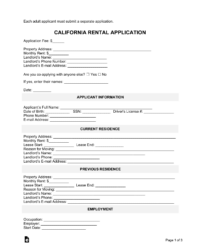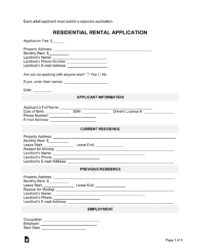Utilizing such a form offers several advantages. It streamlines the application process for both landlords and prospective tenants, promoting transparency and clarity. Standardized documentation helps mitigate legal risks by ensuring compliance with fair housing laws and other relevant regulations. Furthermore, the structured format facilitates efficient comparison of applicants and contributes to a more objective selection process.
This article will further explore key components typically found within these forms, relevant California-specific legal considerations, and best practices for both landlords and tenants when engaging with this crucial step in the rental process.
Key Components of a California Residential Lease Application
Several essential elements comprise a comprehensive application for residential tenancy in California. These components enable landlords to assess applicant suitability thoroughly.
1. Identification Information: This section typically requests the full legal name, date of birth, and contact information of each applicant. Government-issued identification may also be required.
2. Employment and Income Verification: Applicants are generally asked to provide details regarding their current and past employment, including employer contact information, salary, and length of employment. Proof of income through pay stubs, tax returns, or bank statements may be requested.
3. Rental History: Previous addresses, landlord contact information, and reasons for leaving prior residences are commonly requested. This information helps assess an applicant’s rental history and stability.
4. Credit History Authorization: Applications typically include a clause authorizing the landlord to conduct a credit check to assess the applicant’s financial responsibility.
5. Occupancy Details: The number of individuals intending to occupy the premises, including adults and children, is typically requested. This information is crucial for occupancy limit compliance.
6. Pet Information: If applicable, details regarding pets, such as breed, size, and vaccination records, may be requested. Landlords may have specific pet policies.
7. Emergency Contact Information: Contact information for an individual to be notified in case of emergency is typically required.
8. Application Fee Disclosure: The amount of the application fee and any associated terms and conditions should be clearly stated.
Collecting this information facilitates informed decision-making during the tenant selection process, fostering a positive landlord-tenant relationship based on transparency and adherence to legal requirements.
How to Create a California Residential Lease Application
Developing a comprehensive and legally compliant lease application is crucial for California landlords. A well-drafted application helps ensure a smooth tenant screening process and minimizes potential legal risks.
1. Obtain a Template or Draft from Scratch: Utilizing a pre-existing template can expedite the creation process. Alternatively, applications can be drafted from scratch, ensuring all necessary elements are included.
2. Include Essential Identification Fields: Request full legal names, dates of birth, and contact information for each applicant. Consider including a space for government-issued identification numbers.
3. Incorporate Employment and Income Verification Sections: Request details regarding current and past employment, including employer contact information, salary, and length of employment. Specify acceptable forms of income verification.
4. Request Rental History Information: Include fields for previous addresses, landlord contact information, and reasons for leaving prior residences.
5. Include a Credit History Authorization Clause: Ensure the application includes a clear authorization for the landlord to conduct a credit check, complying with relevant legal requirements.
6. Gather Occupancy Details: Request the number of intended occupants, including adults and children, for occupancy limit compliance.
7. Address Pet Policies: If applicable, include sections for pet information, specifying breed, size, and vaccination requirements.
8. Request Emergency Contact Information: Include fields for emergency contact information for each applicant.
9. Disclose Application Fee Details: Clearly state the application fee amount and any associated terms and conditions.
10. Review and Update Regularly: Periodically review and update the application to ensure compliance with current California law and best practices.
A thorough and legally sound application provides landlords with the necessary information to evaluate prospective tenants effectively. Adhering to these guidelines promotes a transparent and efficient application process while mitigating potential legal issues.
Careful consideration of standardized forms for prospective tenants remains crucial for establishing successful landlord-tenant relationships in California. Understanding the key components, legal implications, and best practices associated with these forms allows for a more informed and legally compliant tenant screening process. This knowledge empowers landlords to make sound decisions while promoting transparency and fairness.
Effective utilization of these forms contributes significantly to a more stable and positive rental experience for all parties involved. Continued awareness of evolving regulations and best practices remains essential for navigating the complexities of the California rental market. Properly implemented procedures benefit both landlords and tenants, fostering a more secure and legally sound rental environment.


